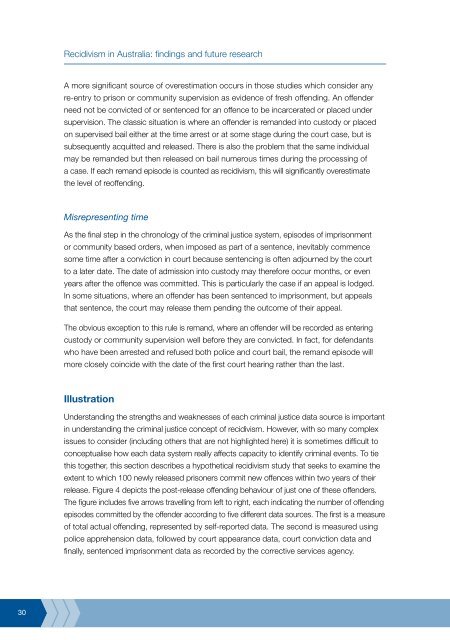Recidivism in Australia : findings and future research - Australian ...
Recidivism in Australia : findings and future research - Australian ...
Recidivism in Australia : findings and future research - Australian ...
Create successful ePaper yourself
Turn your PDF publications into a flip-book with our unique Google optimized e-Paper software.
30<br />
<strong>Recidivism</strong> <strong>in</strong> <strong>Australia</strong>: f<strong>in</strong>d<strong>in</strong>gs <strong>and</strong> <strong>future</strong> <strong>research</strong><br />
A more significant source of overestimation occurs <strong>in</strong> those studies which consider any<br />
re-entry to prison or community supervision as evidence of fresh offend<strong>in</strong>g. An offender<br />
need not be convicted of or sentenced for an offence to be <strong>in</strong>carcerated or placed under<br />
supervision. The classic situation is where an offender is rem<strong>and</strong>ed <strong>in</strong>to custody or placed<br />
on supervised bail either at the time arrest or at some stage dur<strong>in</strong>g the court case, but is<br />
subsequently acquitted <strong>and</strong> released. There is also the problem that the same <strong>in</strong>dividual<br />
may be rem<strong>and</strong>ed but then released on bail numerous times dur<strong>in</strong>g the process<strong>in</strong>g of<br />
a case. If each rem<strong>and</strong> episode is counted as recidivism, this will significantly overestimate<br />
the level of reoffend<strong>in</strong>g.<br />
Misrepresent<strong>in</strong>g time<br />
As the f<strong>in</strong>al step <strong>in</strong> the chronology of the crim<strong>in</strong>al justice system, episodes of imprisonment<br />
or community based orders, when imposed as part of a sentence, <strong>in</strong>evitably commence<br />
some time after a conviction <strong>in</strong> court because sentenc<strong>in</strong>g is often adjourned by the court<br />
to a later date. The date of admission <strong>in</strong>to custody may therefore occur months, or even<br />
years after the offence was committed. This is particularly the case if an appeal is lodged.<br />
In some situations, where an offender has been sentenced to imprisonment, but appeals<br />
that sentence, the court may release them pend<strong>in</strong>g the outcome of their appeal.<br />
The obvious exception to this rule is rem<strong>and</strong>, where an offender will be recorded as enter<strong>in</strong>g<br />
custody or community supervision well before they are convicted. In fact, for defendants<br />
who have been arrested <strong>and</strong> refused both police <strong>and</strong> court bail, the rem<strong>and</strong> episode will<br />
more closely co<strong>in</strong>cide with the date of the first court hear<strong>in</strong>g rather than the last.<br />
Illustration<br />
Underst<strong>and</strong><strong>in</strong>g the strengths <strong>and</strong> weaknesses of each crim<strong>in</strong>al justice data source is important<br />
<strong>in</strong> underst<strong>and</strong><strong>in</strong>g the crim<strong>in</strong>al justice concept of recidivism. However, with so many complex<br />
issues to consider (<strong>in</strong>clud<strong>in</strong>g others that are not highlighted here) it is sometimes difficult to<br />
conceptualise how each data system really affects capacity to identify crim<strong>in</strong>al events. To tie<br />
this together, this section describes a hypothetical recidivism study that seeks to exam<strong>in</strong>e the<br />
extent to which 100 newly released prisoners commit new offences with<strong>in</strong> two years of their<br />
release. Figure 4 depicts the post-release offend<strong>in</strong>g behaviour of just one of these offenders.<br />
The figure <strong>in</strong>cludes five arrows travell<strong>in</strong>g from left to right, each <strong>in</strong>dicat<strong>in</strong>g the number of offend<strong>in</strong>g<br />
episodes committed by the offender accord<strong>in</strong>g to five different data sources. The first is a measure<br />
of total actual offend<strong>in</strong>g, represented by self-reported data. The second is measured us<strong>in</strong>g<br />
police apprehension data, followed by court appearance data, court conviction data <strong>and</strong><br />
f<strong>in</strong>ally, sentenced imprisonment data as recorded by the corrective services agency.















